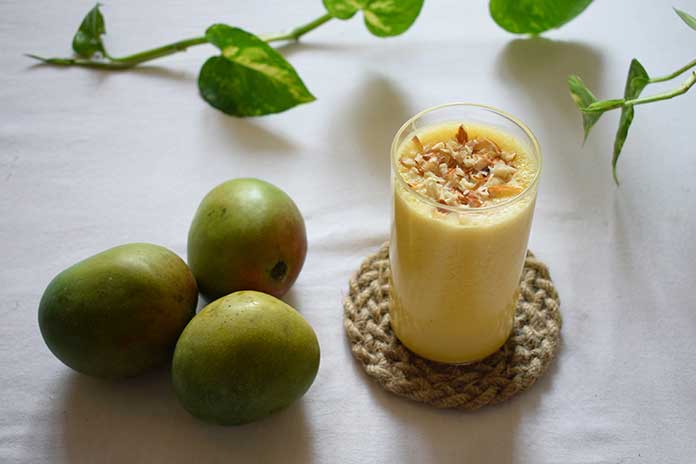In the morning, I like to have a smoothie. Sure, the colorful drinks are also super healthy. Scientists disagree. Here you can get all the information, tips, and tricks for preparation and delicious recipes.
A delicious smoothie in the morning, preferably mixed yourself, of course! It’s super quick and uncomplicated.
Unlike juices, smoothies score with their creaminess and are also more filling. This is what makes the smoothie so popular as a snack. Sure, because one glass covers most of our daily fruit and vegetable needs, right?
Unfortunately, the calculation is not straightforward because sweet drinks can certainly harbor dangers.
What Are Smoothies?
The term “smoothie” is derived from the English term “smooth” (smooth, supple) and thus describes the main characteristic of the drink: smoothies are drinks made from fruit and vegetables that are thicker than juices.
They can be prepared with still water, plant milk such as almond drink or oat milk, and coconut water. They can also be refined with other delicacies, such as vanilla or cinnamon, nuts, seeds, or grated coconut.
That’s The Difference Between Smoothies And Juices
Smoothies and juices differ little in their ingredients; both are prepared with fruit and vegetables and are packed with vitamins, minerals, and health-promoting vital substances.
The difference lies in the preparation. The ingredients are mixed in a smoothie maker or high-performance blender; for juice, the ingredients are squeezed out in a juicer or a cloth.
A smoothie is thicker than a juice because it still contains plant fibers.
The unique thing about smoothies is that they are very high in fiber and stimulate digestion.
Also Read: Chocolates: Why Sweets Are Allowed
Smoothie vs. Juice: Which Is Healthier?
A certain percentage of the vital substances are lost when making smoothies by shredding in the blender.
The plant fibers it contains take a little longer to digest so that the good ingredients can get into the blood.
Juices contain no plant fibers, and no critical vital substances are lost since the ingredients are not shredded but gently squeezed out. Vitamins and Co. get into the blood very quickly because the juice does not have to be digested to a large extent.
But: It doesn’t matter whether you use a blender or a juicer – both methods destroy the cell walls of the ingredients better than chewing. This applies at least to the valuable carotenoids.
Smoothies Are That Healthy
Is the drink a delicious shot of vitamins for in-between meals, or is it actually a secret sugar and chemical trap that has little to do with eating or drinking healthily and certainly does not help you lose weight?
Pro: “Smoothie Closes Vitamin Gaps.”
“Only a few people achieve the ideal recommendation of five portions of fruit and vegetables a day, as the “National Consumption Study” from 2008 shows. 70 percent of the population fail to implement it due to a possible vitamin deficiency. A smoothie is therefore ideal for closing the vitamin gaps.”
the drinks can also be conveniently consumed on the go or in the office. “Chopping and eating a fruit salad takes a lot longer and is more work,” he says.
In addition, a smoothie offers fruits that are not always freshly available – such as raspberries or strawberries. Because you can use the frozen version for smoothies, we can strengthen the immune system, especially in winter, with their ingredients.
The conclusion of the nutrition expert is: “Smoothies are of course no substitute for fresh fruit, but if you have to be quick, the small fruit bottles are healthy and practical.”
Cons: “Smoothies Are Sweet.”
Sugary, not fresh, and therefore not healthy: medical journalist Sven-David Müller is a dietician and is more critical of the colorful drinks. “Schmusie, Schmotti, Smuts – the pronunciation is just as ambiguous as recognizing the ingredients for the consumer. Because these are not mandatory, a smoothie can only consist of fruit, but also of additives and sugar.” A smoothie contains more calories than Coca-Cola.
In his opinion, a smoothie is not the same as fresh, unprocessed fruit. “Smoothies are not fresh fruit; they are industrially processed and therefore have fewer vitamins due to the translucent packaging,”
Another stumbling block on healthy eating with smoothies is the missing chewing process, which is essential for satisfying hunger. If you don’t chew, you’ll get an appetite back much faster.
Müller explains: “The mashed fruits are drunk. Thanks to the chewing, fiber, and larger volume, the fruit has a faster and longer-lasting effect of satiety.”
That’s why his conclusion is contra smoothies: “A smoothie is not suitable for quenching thirst and is not recommended as a daily fruit and vegetable substitute. Eat fruit – smoothies are more like sweets!”
Also Read: The Mayo Diet: How To Lose Weight With Egg & Grapefruit
Do Smoothies Make You Fat?
Prepared incorrectly, the supposedly healthy smoothie quickly becomes a calorie trap. If we mix fruit and top it all off with syrup, this sugar bomb is more of a hindrance to losing weight.
Better: Mix smoothies containing filling foods, such as oatmeal, chia seeds, or yogurt. Then a meal can be replaced by a smoothie and can save a few calories.
Smoothies: Buy vs. Mix Them Yourself
When it comes to smoothies, the motto is: Mixing it yourself is better than buying it. Because often there is not really what you would expect in the smoothies. Studying the list of ingredients properly is the be-all and end-all of store-bought smoothies.
The basis is often not fresh fruit, but fruit juice such as apple juice. In addition, artificial additives or sugar are often buried.
Therefore, when buying, make sure that your smoothie consists only of natural fruit and contains nothing else apart from vegetables, nuts, and seeds.
Added sugar and the like have no place in a real smoothie. That’s why you play it safe when mixing it yourself so that only what you want in your smoothie ends up in it.
Do’s And Don’ts of Smoothie Preparation
Cooking at home offers endless possibilities and enormous variety. Almost all types of fruit and vegetables serve as a basis. Then all you need is a little liquid, and you’re good to go.
So The Preparation Works Guaranteed
- Before preparation, you should wash vegetables and fruit and remove varieties with thick skin, such as bananas. With pears, apples, or carrots, you can puree the peel. The leafy greens of beetroot or carrot can also be mixed in.
- The fruit and vegetables are then cut into rough cubes and placed in the blender. Then add some liquid – water, milk, plant-based milk, juice, or unsweetened tea. The less liquid you use, the thicker and creamier the smoothie.
- If you’re not sure how much liquid to take, just take it slowly and add a little more water or milk if necessary. If the smoothie is too runny, it will taste watery, and the consistency will be more like a juice.
- You can vary the ratio according to your taste. Beginners can start with 70% fruit and 30% liquid. Green smoothies are primarily veggies and typically have a 50:50 fruit-to-veg ratio.
Common Mistakes When Making Smoothies
- Too Much Liquid: There is a large glass of water in the blender, and hey presto, the creamy consistency goes away. Better: Gradually add water to the blender until the right creaminess is reached. Alternatively, you can add a tablespoon of nut butter, oatmeal, or half a banana to the blender to make it a little thicker again.
- Spinach From The Freezer: Hardly any green smoothie can do without spinach. However, make sure you use fresh spinach leaves and not frozen spinach. Most lenders don’t get the frozen spinach tiny. The result: you chew on pieces of spinach. Leaf spinach dissolves better and leaves hardly any fibers in the smoothie.
- The Wrong Mixer: Good smoothie makers don’t have to be super expensive and have 2 hp. It depends on which smoothies you want to mix. A small blender also creates bananas, strawberries, and almond milk. But if you then slowly dare to get to the greens, a high-performance blender is recommended, as it purees spinach, kale, and herbs much more finely.
- Filling The Blender Incorrectly: You mustn’t put all the dry ingredients in the blender first with tall blender jugs. When pureeing, it can happen that the mixer blocks. Better: Fill in some liquid at the bottom, then fruit, vegetables, powder, and seeds and add the remaining liquid at the end. Tip: Do not “stuff” the vegetable leaves into the smoothie container beforehand, but cut them a little smaller beforehand and then add them.


